If you want to learn German in a more structured way, good german learning books are essential.
A textbook gives you a good foundation for learning German as opposed to the scattered videos available on Youtube.
If there is a need for a German exam, German textbooks will also give us a better understanding of what we need for each language level and help us prepare for the exam.
Along my German Learning way, I have tried various German learning books and here are some best selections.
Based on my experience, I have divided the books into three categories:
- Self-study textbooks
- Standardised textbooks
- Grammar textbooks
You can choose the best materials for you according to your needs.
Overviews

Self-Study Textbooks
Standardized Textbook
Grammar Textbooks
Self-Study Textbooks
Assimil – German with Ease
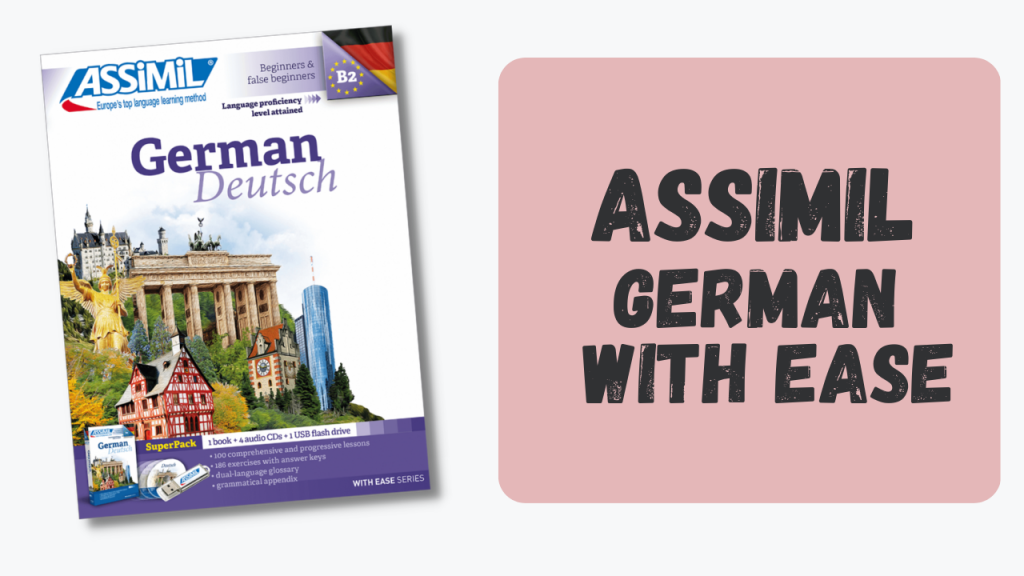
Assimil’s “with ease” series is very popular among polyglots (e.g. Luca Lampariello and Lýdia Machová).
It is in my opinion the most suitable material for self-study at home.
German with Ease is for beginners and false beginners (learners with some basic knowledge).
It is a bilingual textbook. Learners can choose their own source language.
(I chose French, but you can choose English or Spanish as the source language).
There are 100 lessons in German With Ease, ranging in difficulty from A1 to B2. Most of the texts are in the form of dialogues.
Generally speaking, the left-hand page of the textbook is in German and the right-hand page is the translation of the texts (in the source language).
Each lesson provides notes explaining grammatical points, key vocabulary and cultural phenomena in the text.
There are 2 exercises for each lesson, a translation exercise and a fill-in-the-blank exercise (based on the translation).
In addition, there is a review session every seven lessons to summarize the grammar and vocabulary.
Since this is a textbook for beginners, Assimil starts the textbook with a summary of German pronunciation rules.
At the end of the book, there is an appendix with all grammar points and a vocabulary index for the whole book.
So, why do I think it is the best material for self-study?
1. It is a Bilingual Textbook
If you are a beginner in German, it is inevitable that you will be a bit intimidated by a textbook that is all in German.
Besides, with a whole-German textbook, you may not know where to start when studying on your own.
In my experience, it is quite impractical to learn grammar in German right from the start.
We need another language that is more comprehensible for us to understand the grammatical rules better.
All the explanatory parts of Assmil, including vocabulary, grammar and cultural phenomena, are in our source language.
If we encounter unfamiliar words or expressions in the lesson , we can look at the translation on the right side directly.
All these would save us much time and effort.
2. Conversation-focused Contents
Most of the content of a typical textbook is knowledge of German (e.g. grammar rules) and not German itself.
As a result, we learn for a long time, taking dozens of pages of notes, only to find that we have all the notes, but are still unable to say a complete sentence when we speak.
Unlike traditional textbooks, Assimil’s content is mostly in the form of conversations, providing us with many concrete and vivid examples.
By listening, imitating and reading aloud, we can naturally learn the language for everyday conversations.
For people like me who want to speak out the language they learn, Assimil provides the perfect contents for it.
3. Large Amount of Quality Listening Input
The listening materials provided by standarlized textbooks are quite limited. They usually revolve around solving listening test questions, and are not close to real-life situations.
Insufficient listening input prevents us from developing a sense of language.
Without enough listening input, we are likely not be able to communicate properly in our real life.
Since Assimil’s texts are usually dialogues, we can easily create images in our minds with the audio recordings while we are learning.
This in effect helps us to absorb the language better.
Of course, Assimil has its limitations.
1. No Audio in the Phonetic Part
At the very beginning of the textbook, Assimil provides an introduction to German pronunciation rules.
However, there is no specific audio for this section.
As a result, for people who are not familiar with the German phonetics, it would be difficult to learn the correct way to pronounce them.
In this case, you have two options for learning pronunciation:
- watch teaching videos on your own (on Youtube, for example)
- figure out the pronunciation by yourself with the help of the lesson audios.
I recommend you start learning German by going through the German pronunciation rules first.
When you know the rules in the beginning, you can consolidate them later as you proceed with Assimil.
German pronunciation is quite regular, so if you concentrate on it, you can learn it in 2 or 3 days, or a week, if you are short in time.
2. Not Enough Practice in Reading and Writing
Assimil focuses more on speaking and grammar.
Correspondingly, the textbook focuses less on writing and reading. Also, there is not enough specific practice for grammar.
If you need to take a language test at some point, it is not enough to use this material alone.
For exams, you would need to use the standardised textbook (see below) to help grasp the necessary knowledge for each language level.
Standardised Textbooks
Berliner Platz
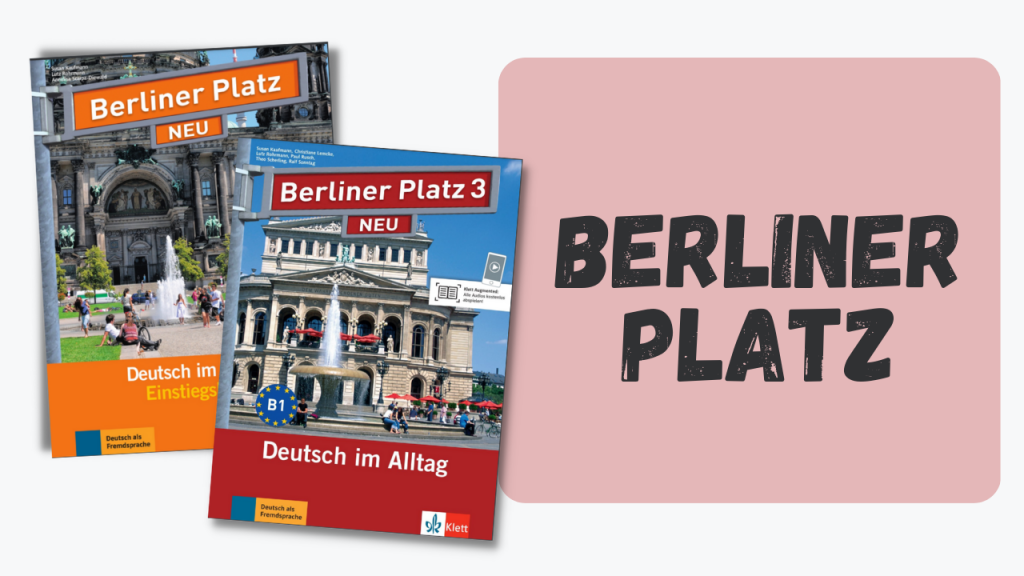
Berliner Platz is so far my favorite textbook for learning German.
The “Berliner Platz” series offers four textbooks from A1 to B2 level, each of which has 12 chapters based on different topics.
Each chapter has around 9 activities covering exercises for listening, speaking, reading and writing. The activities are also relatively easy to follow and digest.
At the end of each chapter, there is a review page. It lists the key expressions and grammar points of each chapter for reviewing and exam preparation.
The second half of the textbook is a workbook. Each task in the exercise book corresponds to an activity in the textbook.
In this way, we can easily review the relevant expressions needed for each exercise.
One feature of Berliner Platz is that it is not too voluminous.
The content is practical and close to life, and the pages are colorful and lively.
The combination of these features makes the learning process easier and you will have a feeling of moving forward all the time.
If you prefer a more relaxed, unburdened learning experience and want to master the basics of German in the shortest possible time, I recommend the textbook “Berliner Platz”.
Note that it is an all-German textbook, so for complete beginners, it is ideal to pair it with instructional videos or have a teacher who guides you.
If you already have some German foundation (for example, you have learned about 50 lessons in Assimil), and you are using the textbook to consolidate your knowledge, then you are good to go.
Otherwise, using an all-German textbook at the beginning may be a bit of a challenge.
There is a high probability that you will not be able to read the guidance in the textbook.
Aspekte Neu
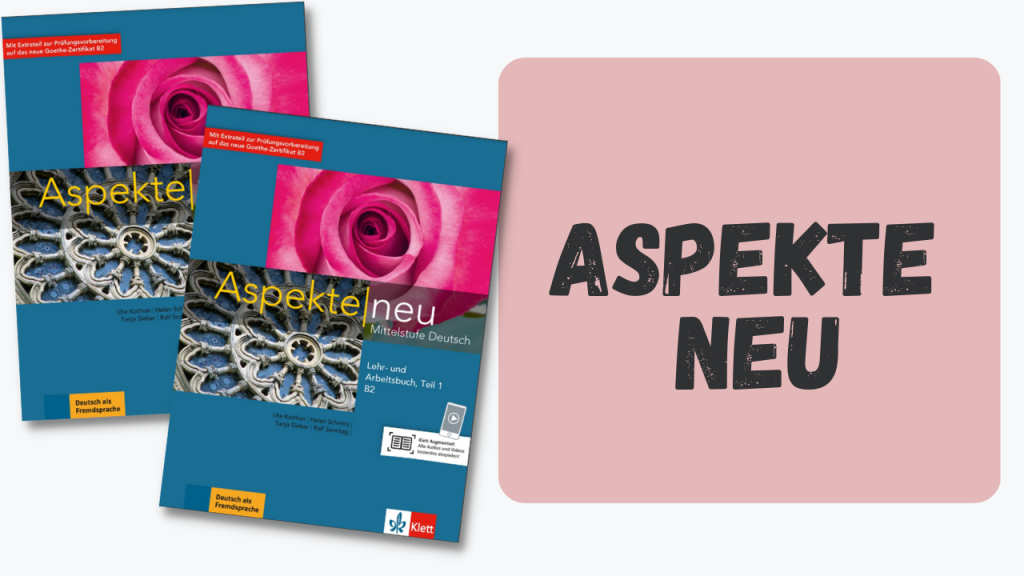
Aspekte Neu and Berliner Platz are both textbooks of the Klett publishing house. Compared to Berliner Platz, Aspekte Neu is more comprehensive and intensive.
Take the B2 textbook as an example, it contains two books, each of them has five chapters.
Each chapter has a prologue, four sub-chapters, a grammar summary, portrait as well as a film session at the end.
The portrait is usually an article about a person or a company, while the movie is a film specifically made for the chapter, followed by accompanying activities (quiz, crossword, answer questions, etc.).
The second half of each textbook is a workbook. But the exercises in the workbook do not correspond to the previous learning sessions.
This design requires a higher understanding of the overall language skill of the learners.
If you prefer a more informative and varied textbook, then Aspekte Neu can be a better choice than Berliner Platz.
On the other hand, since there are more contents, the learning process is slower and it may feel a bit burdensome.
According to my experience, since there are many activities, there is inevitably a bit of clutter. It can also be a bit overwhelming when reviewing.
Like Berliner Platz, this is an all-German textbook, so it would be ideal for beginners to study with a course or with a teacher.
Begegnungen, Erkundungen
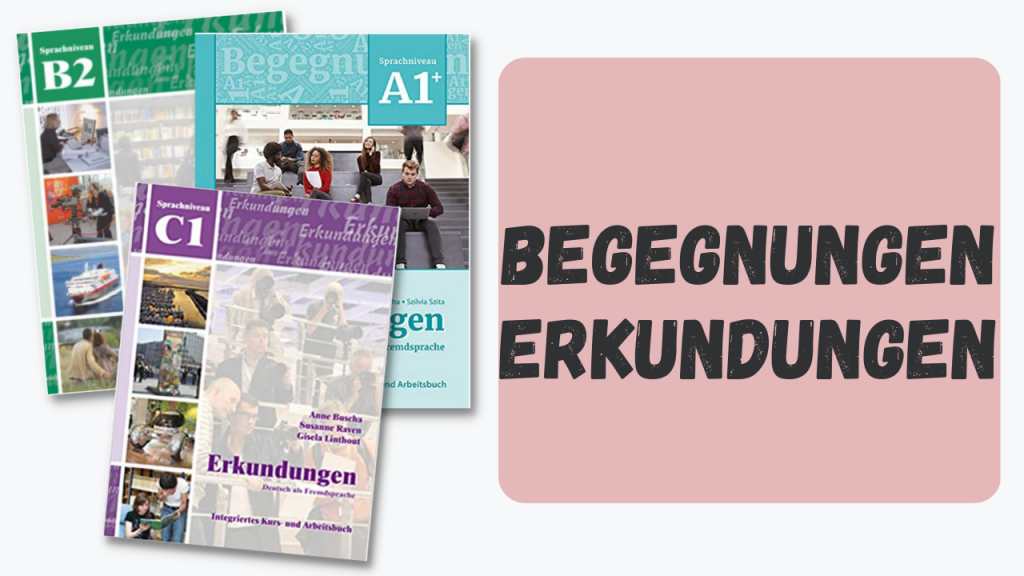
This is a set of textbooks from Schubert publishing house, offering 6 textbooks from A1 to C2.
Begegnungen is for A1-B1, and Erkundungen is for B2-C2.
On the whole, it is a hard-core textbook, with solid content and many exercises, but less interesting.
1. Single-color Inside Pages
Compared to Berliner Platz and Aspekte Neu, the pages are not as colorful. There are also not many illustrations, and if there are, they are only in black and white.
2. High Density of Exercises
In terms of density, it is the most dense of the textbooks mentioned in this post.
The whole textbook is full of various exercises, like reading, sentence construction, linking, word choice, and right/wrong questions etc..
3. Not Enough Listening Practice for Advanced Level
Take the B2 textbook, there are only 14 listening exercises, while C1 only has 13.
If you want to improve your listening skills, it is not enough with the book. You need to find some listening materials by yourself.
4. Difficult
I used this book during my language course at a German university. After that, I used the B2 textbook for an online class and then the C1 textbook for a language school in Germany.
My feeling is that each textbook is one level higher than the cover indicates. A2 textbooks are almost B1 level, B2 textbooks are almost C1.
My B2 German teacher at the time also said, “Das ist kein b2 (It is not b2)”.
Well, if you prefer more challenging textbooks, then this set is a good choice.
However, because of the difficulty, there is also a risk of discouragement when using this textbook.
5. Small-sized Letters
With the small-sized letters, it is slightly tight to do either exercises or take notes in the book. It can also be tiring to look at.
If you like hard-core textbooks with high-density content, then this is a textbook you can try.
If you think the questions in the textbook are too difficult as you use the book, don’t be discouraged.
It’s not your problem, it’s just that the textbook is more difficult than it indicates.
Grammar Textbooks
Grammatik Aktiv

The Grammatik Aktiv series has three books:
- The beginner’s textbook covers grammar points from a1 to b1.
- The intermediate textbook covers grammar points from b1 to b2.
- The advanced textbook covers grammar points from b2 to c1.
The intermediate textbook comes out later than the other two, so is more of a consolidation and review material.
Each chapter begins with a brief explanation of the grammar point, followed by about 6-8 small exercises.
Besides each exercise, there is a note indicating the language level to which the exercise corresponds.
On the whole, each grammar point, including the introduction and exercises, is only two pages long, so it is not too burdensome to work with.
However, because of the small number of pages allocated to each grammar point, the layout of some exercises is rather compact.
Since there is not enough space for writing, you might need an extra notebook for some exercises (such as the sentence-building exercises).
The inside pages of this book are of color, so it is visually more comfortable (at least for me).
Note that is a German book, and I can imagine that it would be a bit more difficult for complete beginners to work with.
German Grammar Drills
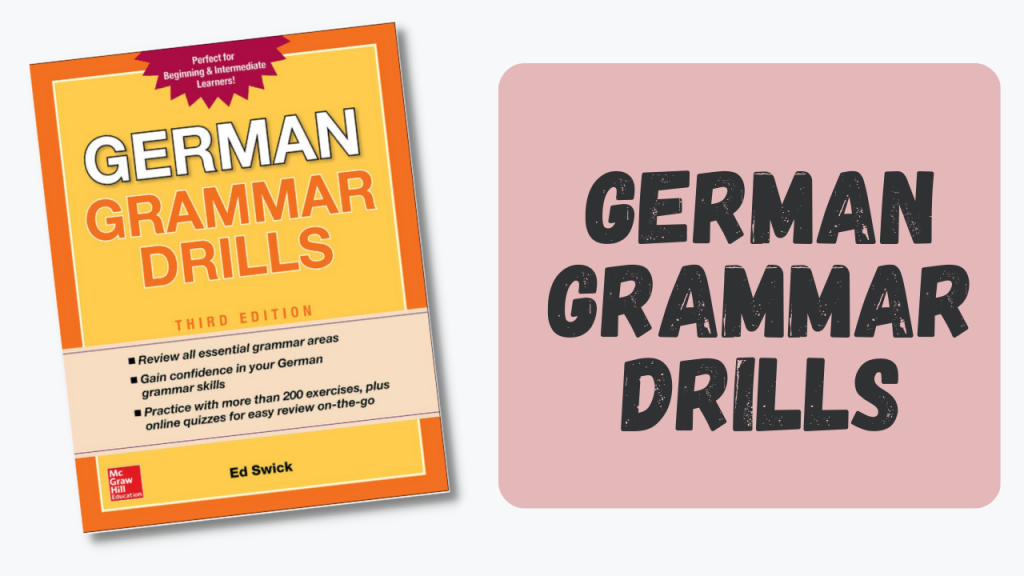
Unlike Grammatik Aktiv, this book is bilingual (in German and English). For the complete beginner in German, it is easier to learn with English explanations.
Compared to Grammatik Aktiv, German Grammar Drills is more detailed in its explanations.
Whether this is good or bad depends on the needs of the individual learner.
After the explanations, each chapter contains 5 exercises. For every 9 chapters there is a review session to reinforce the grammar points learned earlier.
The interior design of this book is the opposite of Grammatik Aktiv.
- First, the pages are plain and black and white.
- Second, it provides enough writing space for the exercises, so that learners can directly write in this book.
In my experience, this design is also more convenient when it comes to revision. No need to go back and forth between the book and the textbook.
The Bottom Line
To summarize,
If you want to learn German complete on your own, you can choose
Assimil: German with Ease
- if the focus of your learning is on speaking and listening.
- If you need to take a German language exam, you can use it together with a standardized textbook.
If you have a teacher, or wish to learn with instructional videos, you can choose
Berliner Platz:
- if you want to master the most critical grammar, vocabulary and expressions for the A1-B2 levels in the shortest possible time.
Aspekte Neu:
- if you prefer a more extensive learning textbook (with more exercises, videos, articles, audios, etc.)
Begegnungen, Erkundungen:
- if you like hardcore, high-density learning
If you want to learn German grammar systematically, you can choose
Grammatik Aktiv:
- if you already have some basic knowledge and want to consolidate your grammar.
- if you prefer a more lively designed textbook.
German Grammar Drills:
- if you like bilingual textbooks.
- if you want to learn grammar on your own by reading.
- if you like to do exercises in the book.
Have you use some German textbooks before? How was you experience? Do you have any recommendations? Leave a comment and share with us!






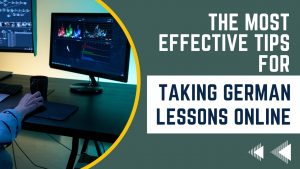
3 thoughts on “6 Best German Textbooks Recommendation for Learners”
Very nice post. I definitely appreciate this site. Stick with it!
Thank you very much!